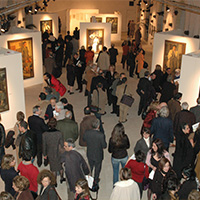Criticism
Nella Zoja
Many pictures made, many destroyed, relatively few of them saved from his dissatisfaction. His own dissatisfaction, fuelled by a critical spirit that hammer away at an extremely personal temperament, the tough patience of keeping his work to himself only for a long time, to not give in to any public criticism, not to derogate from that which he had set his sights on, were the worst thrown to the future faith of his work. Saved by life, by the youth, he just had that. His work, his life: to a degree of identification, that only the predestined creatures reach.
Antonello Zintu
He was born with the surname Cugusi, but our painter, convinced that names had importance on the lives of individuals, loved to be called da Romana, his birth place, a town of a few thousand souls, in Sardinia. He lived to be thirty-nine, or rather suffered and struggled, and to satisfy his insatiable soul and to appease his burning thirst to manifest, which one feels, in work that tastes eternal. One notices throughout all of Cugusiana art a spiritual quest, an inner profound understanding of humanity, especially that of a more sincere age, that of childhood and youth.
Vittorio Sgarbi
Brancaleone Cugusi da Romana was a formidable photographer. The Canvas of Brancaleone da Romana are all life size; which comes guaranteed from the procurement of the grid, which allows no deviation, non even one millimetre from the prototype photograph. Brancaleone Cugusi did not copy the photograph. The soul was in the painting, and in the skill of capturing the element that escapes the photograph, the shadow.
No painter, not even Caravaggio has painted shadows like Cugusi. He draws and paints on canvas using a paint of fluid and mobile paste, the one he used to call “a tutta pasta”.
